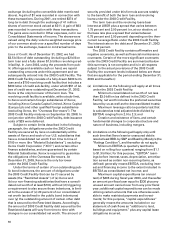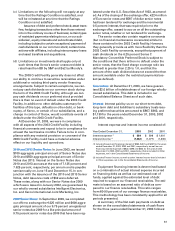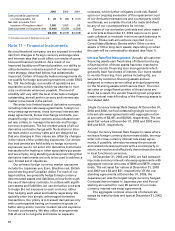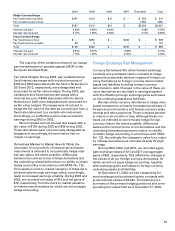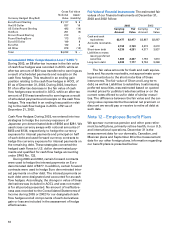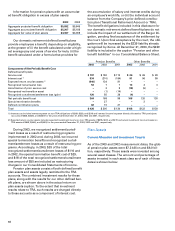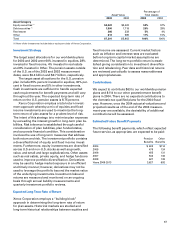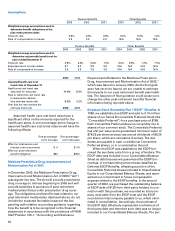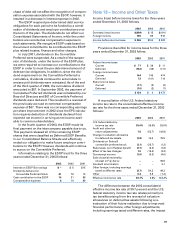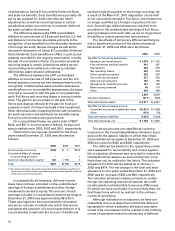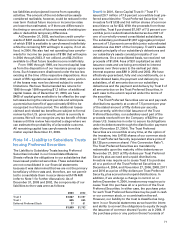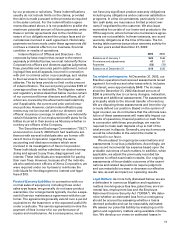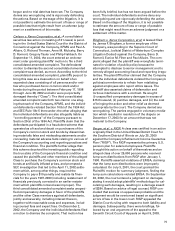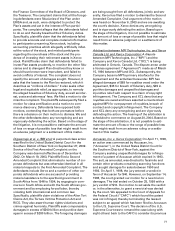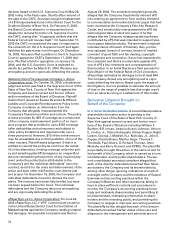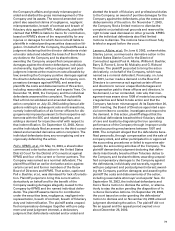Xerox 2003 Annual Report Download - page 72
Download and view the complete annual report
Please find page 72 of the 2003 Xerox annual report below. You can navigate through the pages in the report by either clicking on the pages listed below, or by using the keyword search tool below to find specific information within the annual report.
70
of dividends on Series B Convertible Preferred Stock
and state tax benefits. Such benefits were partially off-
set by tax expense for audit and other tax return
adjustments, as well as recurring losses in certain
jurisdictions where we continue to maintain deferred
tax asset valuation allowances.
The difference between the 2002 consolidated
effective income tax rate of 3.8 percent and the U.S. fed-
eral statutory income tax rate relates primarily to the
recognition of tax benefits from the favorable resolution
of a foreign tax audit, tax law changes as well as the
retroactive declaration of Series B Convertible Preferred
Stock dividends. Such benefits are offset, in part, by tax
expense recorded for the ongoing examination in India,
the sale of our interest in Katun Corporation as well as
recurring losses in certain jurisdictions where we are
not providing tax benefits and continue to maintain
deferred tax asset valuation allowances.
The difference between the 2001 consolidated
effective income tax rate of 144.2 percent and the U.S.
federal statutory income tax rate relates primarily to the
recognition of deferred tax asset valuation allowances
resulting from our recoverability assessments, the taxes
incurred in connection with the sale of our partial inter-
est in Fuji Xerox and recurring losses in low tax jurisdic-
tions. The gain for tax purposes on the sale of Fuji
Xerox was disproportionate to the gain for book pur-
poses as a result of a lower tax basis in the investment.
Other items favorably impacting the tax rate included a
tax audit resolution and additional tax benefits arising
from prior period restructuring provisions.
On a consolidated basis, we paid a total of $207,
$442, and $57 in income taxes to federal, foreign and
state jurisdictions in 2003, 2002 and 2001, respectively.
Total income tax expense (benefit) for the three
years ended December 31, 2003 was allocated as
follows:
2003 2002 2001
Income taxes on income $134 $ 4 $473
Cumulative effect of change
in accounting principle ––1
Common shareholders’ equity(1) 123 (173) 1
Total $257 $(169) $475
(1) For dividends paid on Series B Convertible Preferred Stock, tax effects of
items in accumulated other comprehensive loss and tax benefits related to
stock option and incentive plans.
In substantially all instances, deferred income
taxes have not been provided on the undistributed
earnings of foreign subsidiaries and other foreign
investments carried at equity. The amount of such
earnings included in consolidated retained earnings at
December 31, 2003 was approximately $5 billion.
These earnings have been permanently reinvested
and we do not plan to initiate any action that would
precipitate the payment of income taxes thereon. It is
not practicable to estimate the amount of additional
tax that might be payable on the foreign earnings. As
a result of the March 31, 2001 disposition of one-half
of our ownership interest in Fuji Xerox, the investment
no longer qualified as a foreign corporate joint ven-
ture. Accordingly, deferred taxes are required to be
provided on the undistributed earnings of Fuji Xerox,
arising subsequent to such date, as we no longer have
the ability to ensure permanent reinvestment.
The tax effects of temporary differences that give
rise to significant portions of the deferred taxes at
December 31, 2003 and 2002 were as follows:
2003 2002
Tax effect of future tax deductions
Research and development $ 1,238 $ 1,142
Post-retirement medical benefits 491 487
Depreciation 482 475
Net operating losses 442 416
Other operating reserves 262 230
Tax credit carryforwards 237 204
Deferred compensation 182 159
Allowance for doubtful accounts 151 162
Restructuring reserves 69 174
Other 340 356
3,894 3,805
Valuation allowance (577) (524)
Total deferred tax assets $ 3,317 $ 3,281
Tax effect of future taxable income
Unearned income and installment sales $(1,421) $(1,363)
Other (112) (76)
Total deferred tax liabilities (1,533) (1,439)
Total deferred taxes, net $ 1,784 $ 1,842
The above amounts are classified as current or
long-term in the Consolidated Balance Sheets in accor-
dance with the asset or liability to which they relate.
Current deferred tax assets at December 31, 2003 and
2002 amounted to $402 and $449, respectively.
The deferred tax assets for the respective periods
were assessed for recoverability and, where applica-
ble, a valuation allowance was recorded to reduce the
total deferred tax asset to an amount that will, more
likely than not, be realized in the future. The valuation
allowance for deferred tax assets as of January 1,
2002 was $474. The net change in the total valuation
allowance for the years ended December 31, 2003 and
2002 was an increase of $53 and $50, respectively.
The valuation allowance relates primarily to certain
foreign net operating loss carryforwards, tax credit
carryforwards and deductible temporary differences
for which we have concluded it is more likely than not
that these items will not be realized in the ordinary
course of operations.
Although realization is not assured, we have con-
cluded that it is more likely than not that the deferred
tax assets for which a valuation allowance was deter-
mined to be unnecessary will be realized in the ordinary
course of operations based on scheduling of deferred


